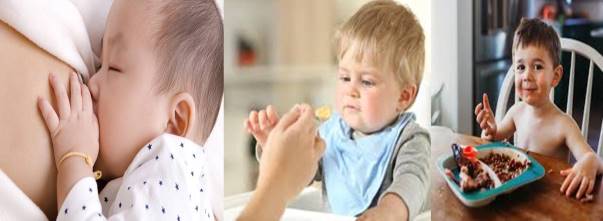Iron is a mineral and every person needs
it to do their job and make hemoglobin. Hemoglobin is a red blood cell that
carries oxygen to other parts of the body. If a child is deficient in iron, it
is called anemia. This means that the body's cells are not getting the right
amount of oxygen, which causes the baby to turn pale and feel weak, tired and
irritable.
Causes of iron deficiency or anemia in
the body?
Children need constant iron to grow up,
otherwise the body becomes deficient in iron. Children who do not eat iron-rich
foods or whose body refuses to take iron have anemia.
Possible causes of iron deficiency
Breastfeeding
That is, feeding 20 ounces or 570
milliliters or more of juice per day, that is, more than 4 ounces or 115
milliliters of juice a day.
Even after the age of two, bottle-fed
babies are at higher risk of developing anemia.
The child eats foods that are low in
iron.
Heme iron diet (easily absorbed)
Large meats (hamburgers, beef liver, corn
beef, steak), small meats such as chicken, turkey (its meat is high in iron),
fish (haddock, halibut, salmon, tuna), sausages, clams or oysters.
Non Heme Iron (Hardly Absorbed)
Iron-containing formula or cereal, wheat
cream, porridge, iron-rich breakfast cereals, beans, kabali gram, lentils,
cooked beans (inside cans), oven-baked potatoes (including peels), dried fruits
, Dried apricots, dried figs, fruits, prawn juice, high quality pasta, high
quality rice, hard tofu, jaggery, black stripe, broccoli, spinach.
Iron foods
Iron is found in animal and plant foods.
Iron obtained from animals is called heme iron. Plant-derived iron is called
non-heme iron. Our bodies are able to absorb heme iron better than non-heme
iron.
Acquisition of iron in different age
groups
Newborns: Breast milk keeps babies from
anemia from 4 to 6 months of age, after which babies need iron from other
sources, such as iron-rich cereals and meat. If you have decided to bottle-feed
your baby, give him iron-fed milk until he is one year old.
Don't use low iron milk. These formulas
do not contain enough iron to meet a child's iron needs. It is important to
make sure that the baby is getting enough iron, especially babies who have been
breastfed for six months. Start giving them cereals full of meat and iron as
their first food.
The Iron Serial will be started at the
age of 6 months and should be continued till the age of 2 years. Meat is the
best source of iron, more meat means more iron. If you like to give your child
a vegetarian diet, give him medium or hard tofu, peas, lentils and beans.
Babies and newborns: Babies who drink a
lot of milk or juice suffer from anemia. To provide more iron to children over
the age of two, take the following steps:
Release the baby bottle and start
breastfeeding from the cup.
Do not give more than two cups of milk a
day, ie 16 ounces or 450 ml.
Eat a diet rich in iron every day.
How can iron deficiency be met?
It is important to give your child a
supplement (ferrous sulfate) to treat iron deficiency, which requires
consulting a pediatrician. If iron supplement is given with vitamin C, it is
digested quickly or it should be given on an empty stomach. If given with food,
its effect is reduced. Iron supplements should not be given with milk or
anything made from milk.
How to avoid iron deficiency?
Do not give babies more than two cups of
cow's milk (16 ounces or 450 ml) daily. Half a cup of juice to one cup daily (4
to 8 ounces). Give daily beef, goat meat, dark turkey or liver, kidney, etc.
Serial, double bread, rice, pasta with the words 'enriched' or 'fortified'
written on it, daily. You can also provide the following items:
Serve stressful fruits (malt, grapefruit,
tomato) with foods that increase iron intake, for example, malt juice with
burgers, malt squeezed on top of meat, chicken with broccoli, spaghetti, With
meatballs and tomato sauce, use the water that comes out of beans or peas in
cans or cans in soups, curries or stews.
Sprinkle dried fruits (raisins, prawns,
dates, apricots) on the cereal and feed the fruits mixed with cereal for lunch,
sweet and hot milk. Mix large meat in tomato and pasta sauce, cook large meat
in macaroni and cheese. Whole-wheat double bread and cereal, use wheat cream
and wheat porridge, give the baby water between meals and snacks.
















0 Comments
Please do not enter any spam link in the comments box